Critically Discussing Key Elements to Create a Brand Identity
VerifiedAdded on 2023/06/10
|11
|3028
|222
Essay
AI Summary
This essay critically discusses the key elements that an organization might use to create an identity for its brand. It emphasizes the importance of making the brand memorable, meaningful, linkable, transferable, adaptable, and protectable. The essay uses examples of successful and unsuccessful branding strategies from companies like Maggie, Samsung, Google, Yahoo, McDonald's, KFC, Coca-Cola, Amazon, and Microsoft to illustrate these elements. It highlights how brand awareness, customer perception, URL selection, company vision, visual and verbal imagery, and adaptability to cultural and market changes all play crucial roles in shaping a brand's identity and equity. The document also considers the legal and competitive aspects of protecting a brand's identity in the global market. This comprehensive analysis provides valuable insights for understanding and creating a strong brand identity.
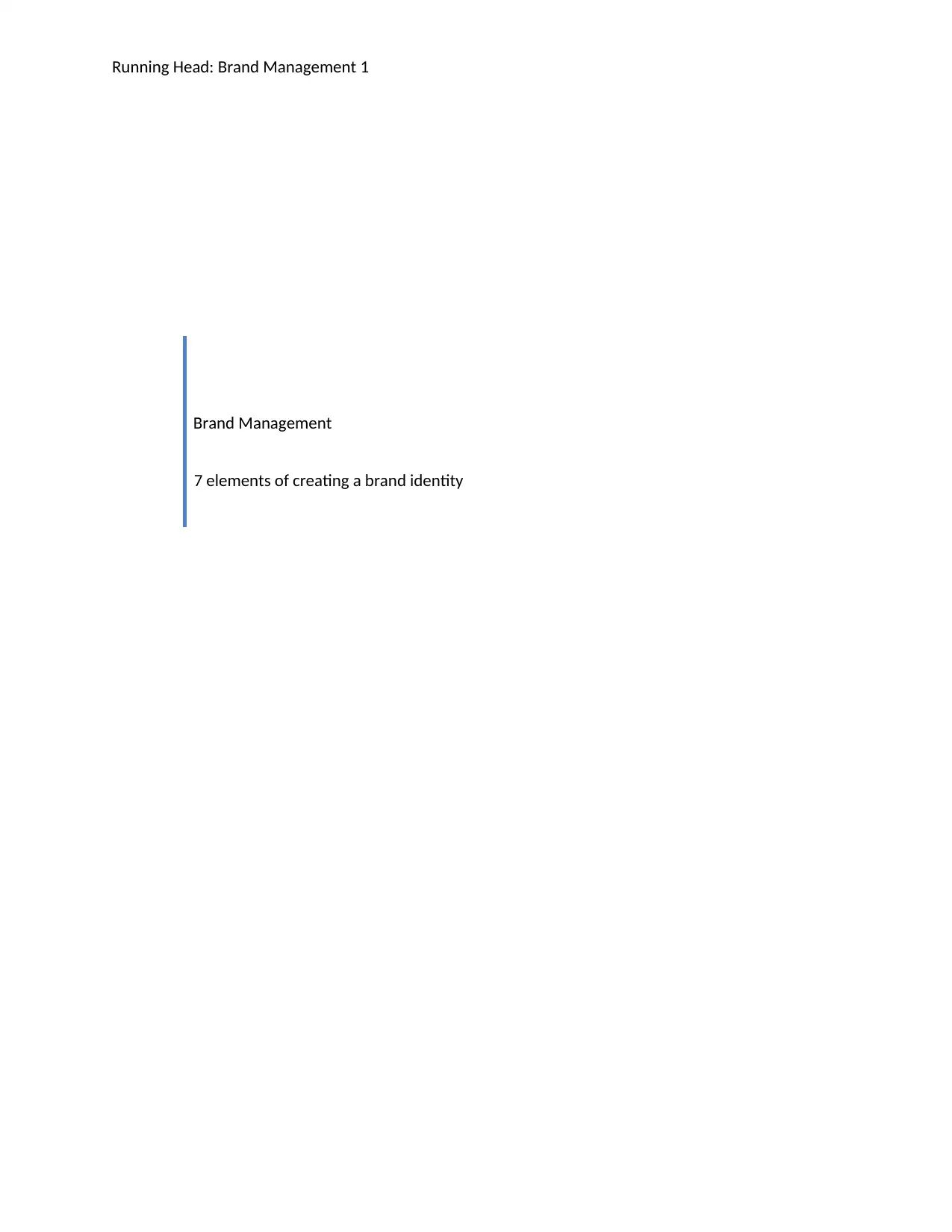
Running Head: Brand Management 1
Brand Management
7 elements of creating a brand identity
Brand Management
7 elements of creating a brand identity
Paraphrase This Document
Need a fresh take? Get an instant paraphrase of this document with our AI Paraphraser
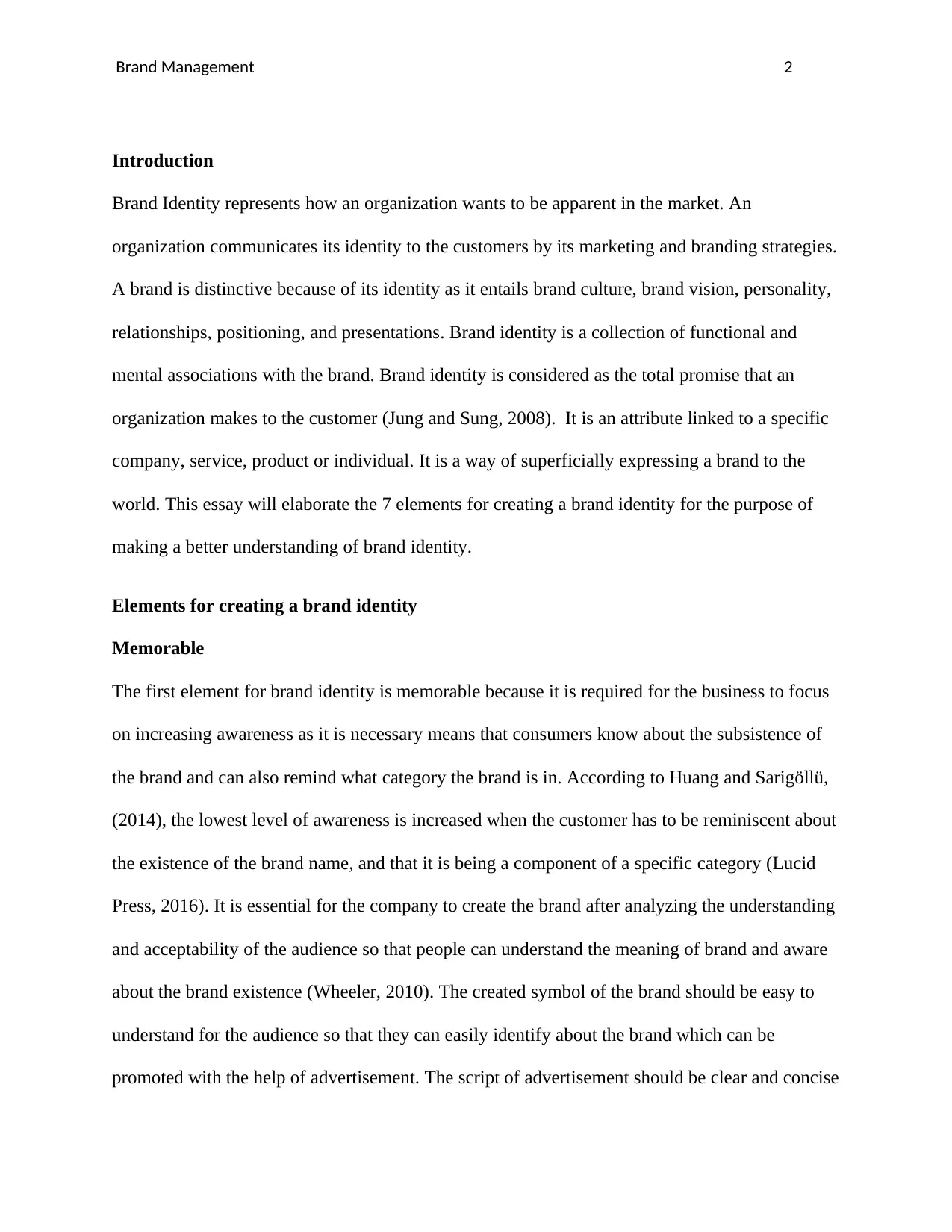
Brand Management 2
Introduction
Brand Identity represents how an organization wants to be apparent in the market. An
organization communicates its identity to the customers by its marketing and branding strategies.
A brand is distinctive because of its identity as it entails brand culture, brand vision, personality,
relationships, positioning, and presentations. Brand identity is a collection of functional and
mental associations with the brand. Brand identity is considered as the total promise that an
organization makes to the customer (Jung and Sung, 2008). It is an attribute linked to a specific
company, service, product or individual. It is a way of superficially expressing a brand to the
world. This essay will elaborate the 7 elements for creating a brand identity for the purpose of
making a better understanding of brand identity.
Elements for creating a brand identity
Memorable
The first element for brand identity is memorable because it is required for the business to focus
on increasing awareness as it is necessary means that consumers know about the subsistence of
the brand and can also remind what category the brand is in. According to Huang and Sarigöllü,
(2014), the lowest level of awareness is increased when the customer has to be reminiscent about
the existence of the brand name, and that it is being a component of a specific category (Lucid
Press, 2016). It is essential for the company to create the brand after analyzing the understanding
and acceptability of the audience so that people can understand the meaning of brand and aware
about the brand existence (Wheeler, 2010). The created symbol of the brand should be easy to
understand for the audience so that they can easily identify about the brand which can be
promoted with the help of advertisement. The script of advertisement should be clear and concise
Introduction
Brand Identity represents how an organization wants to be apparent in the market. An
organization communicates its identity to the customers by its marketing and branding strategies.
A brand is distinctive because of its identity as it entails brand culture, brand vision, personality,
relationships, positioning, and presentations. Brand identity is a collection of functional and
mental associations with the brand. Brand identity is considered as the total promise that an
organization makes to the customer (Jung and Sung, 2008). It is an attribute linked to a specific
company, service, product or individual. It is a way of superficially expressing a brand to the
world. This essay will elaborate the 7 elements for creating a brand identity for the purpose of
making a better understanding of brand identity.
Elements for creating a brand identity
Memorable
The first element for brand identity is memorable because it is required for the business to focus
on increasing awareness as it is necessary means that consumers know about the subsistence of
the brand and can also remind what category the brand is in. According to Huang and Sarigöllü,
(2014), the lowest level of awareness is increased when the customer has to be reminiscent about
the existence of the brand name, and that it is being a component of a specific category (Lucid
Press, 2016). It is essential for the company to create the brand after analyzing the understanding
and acceptability of the audience so that people can understand the meaning of brand and aware
about the brand existence (Wheeler, 2010). The created symbol of the brand should be easy to
understand for the audience so that they can easily identify about the brand which can be
promoted with the help of advertisement. The script of advertisement should be clear and concise
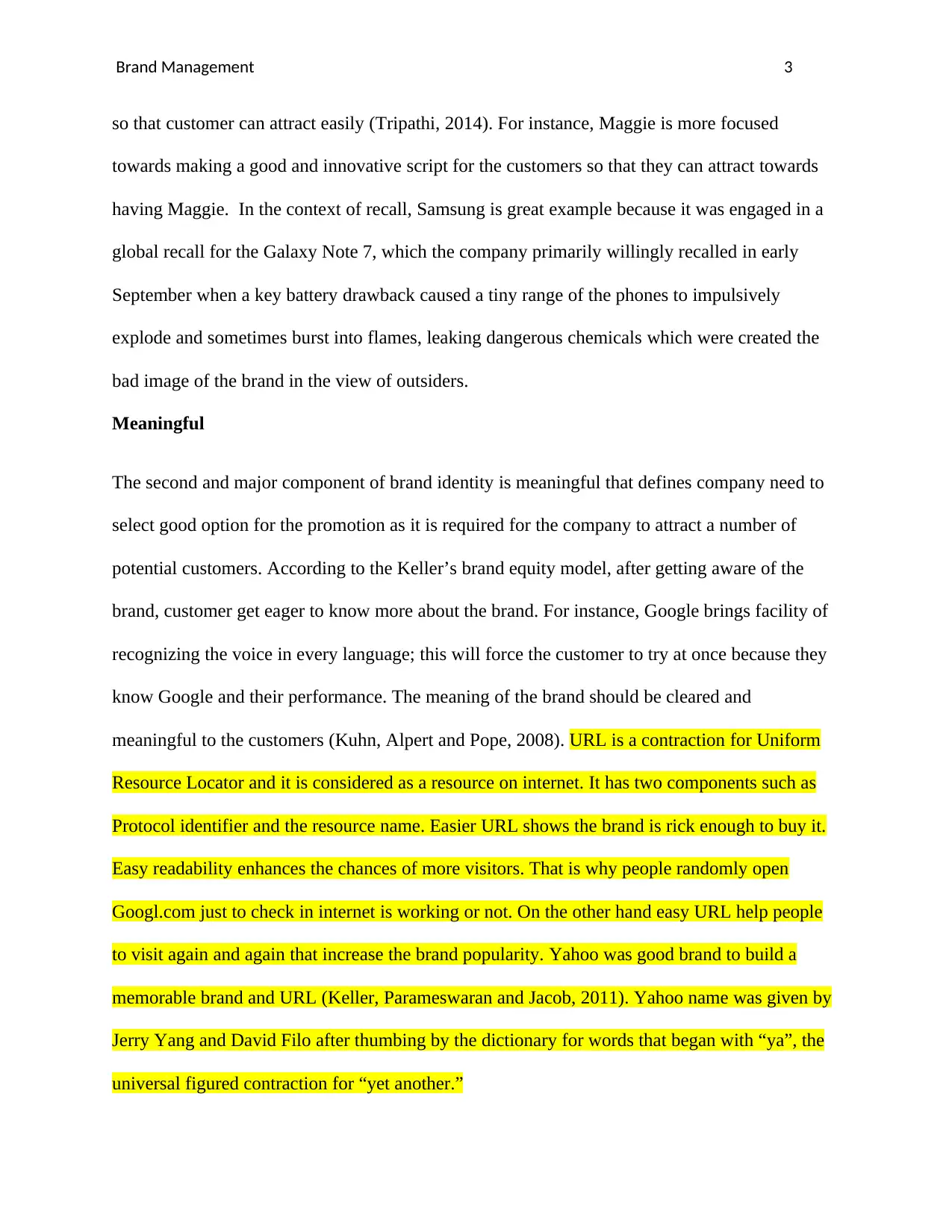
Brand Management 3
so that customer can attract easily (Tripathi, 2014). For instance, Maggie is more focused
towards making a good and innovative script for the customers so that they can attract towards
having Maggie. In the context of recall, Samsung is great example because it was engaged in a
global recall for the Galaxy Note 7, which the company primarily willingly recalled in early
September when a key battery drawback caused a tiny range of the phones to impulsively
explode and sometimes burst into flames, leaking dangerous chemicals which were created the
bad image of the brand in the view of outsiders.
Meaningful
The second and major component of brand identity is meaningful that defines company need to
select good option for the promotion as it is required for the company to attract a number of
potential customers. According to the Keller’s brand equity model, after getting aware of the
brand, customer get eager to know more about the brand. For instance, Google brings facility of
recognizing the voice in every language; this will force the customer to try at once because they
know Google and their performance. The meaning of the brand should be cleared and
meaningful to the customers (Kuhn, Alpert and Pope, 2008). URL is a contraction for Uniform
Resource Locator and it is considered as a resource on internet. It has two components such as
Protocol identifier and the resource name. Easier URL shows the brand is rick enough to buy it.
Easy readability enhances the chances of more visitors. That is why people randomly open
Googl.com just to check in internet is working or not. On the other hand easy URL help people
to visit again and again that increase the brand popularity. Yahoo was good brand to build a
memorable brand and URL (Keller, Parameswaran and Jacob, 2011). Yahoo name was given by
Jerry Yang and David Filo after thumbing by the dictionary for words that began with “ya”, the
universal figured contraction for “yet another.”
so that customer can attract easily (Tripathi, 2014). For instance, Maggie is more focused
towards making a good and innovative script for the customers so that they can attract towards
having Maggie. In the context of recall, Samsung is great example because it was engaged in a
global recall for the Galaxy Note 7, which the company primarily willingly recalled in early
September when a key battery drawback caused a tiny range of the phones to impulsively
explode and sometimes burst into flames, leaking dangerous chemicals which were created the
bad image of the brand in the view of outsiders.
Meaningful
The second and major component of brand identity is meaningful that defines company need to
select good option for the promotion as it is required for the company to attract a number of
potential customers. According to the Keller’s brand equity model, after getting aware of the
brand, customer get eager to know more about the brand. For instance, Google brings facility of
recognizing the voice in every language; this will force the customer to try at once because they
know Google and their performance. The meaning of the brand should be cleared and
meaningful to the customers (Kuhn, Alpert and Pope, 2008). URL is a contraction for Uniform
Resource Locator and it is considered as a resource on internet. It has two components such as
Protocol identifier and the resource name. Easier URL shows the brand is rick enough to buy it.
Easy readability enhances the chances of more visitors. That is why people randomly open
Googl.com just to check in internet is working or not. On the other hand easy URL help people
to visit again and again that increase the brand popularity. Yahoo was good brand to build a
memorable brand and URL (Keller, Parameswaran and Jacob, 2011). Yahoo name was given by
Jerry Yang and David Filo after thumbing by the dictionary for words that began with “ya”, the
universal figured contraction for “yet another.”
⊘ This is a preview!⊘
Do you want full access?
Subscribe today to unlock all pages.

Trusted by 1+ million students worldwide
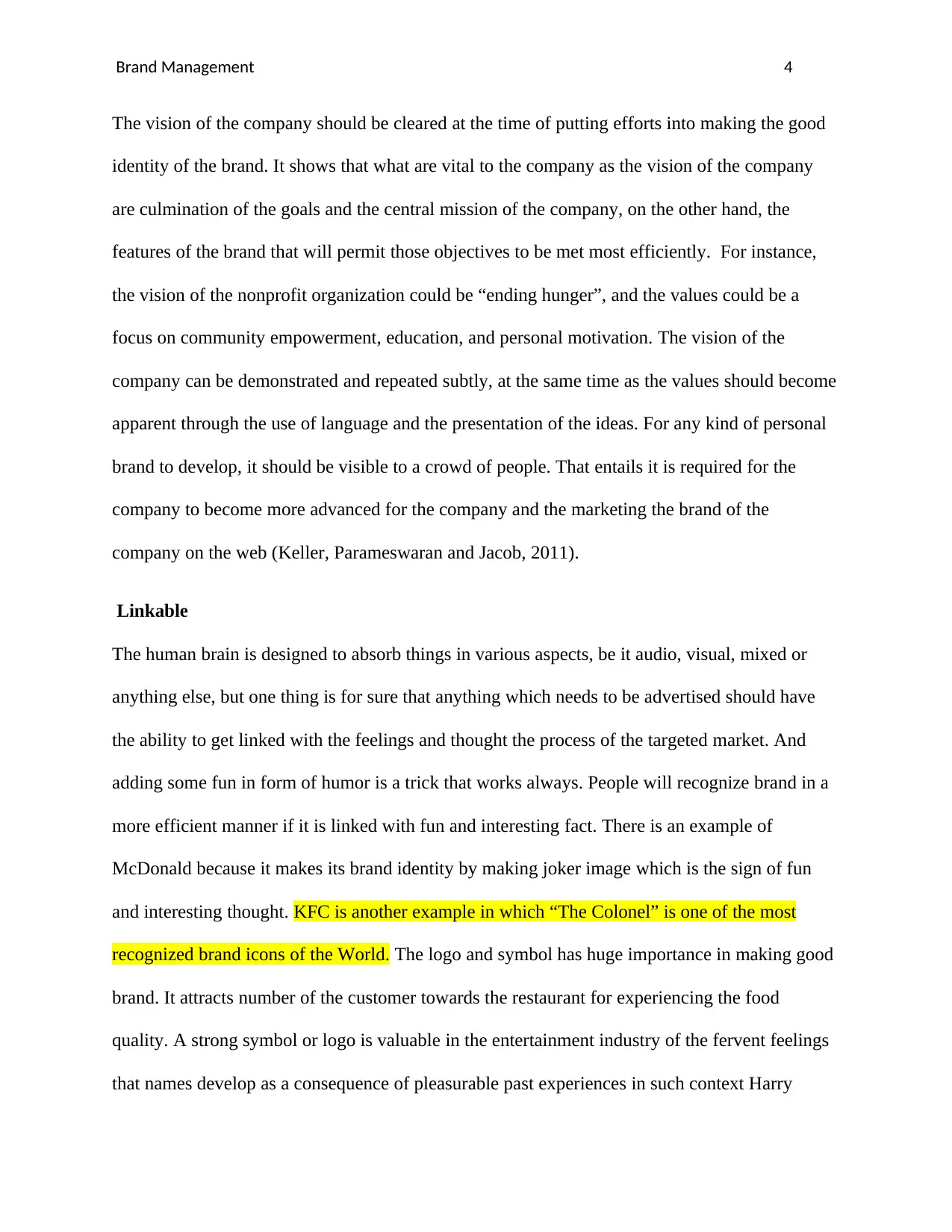
Brand Management 4
The vision of the company should be cleared at the time of putting efforts into making the good
identity of the brand. It shows that what are vital to the company as the vision of the company
are culmination of the goals and the central mission of the company, on the other hand, the
features of the brand that will permit those objectives to be met most efficiently. For instance,
the vision of the nonprofit organization could be “ending hunger”, and the values could be a
focus on community empowerment, education, and personal motivation. The vision of the
company can be demonstrated and repeated subtly, at the same time as the values should become
apparent through the use of language and the presentation of the ideas. For any kind of personal
brand to develop, it should be visible to a crowd of people. That entails it is required for the
company to become more advanced for the company and the marketing the brand of the
company on the web (Keller, Parameswaran and Jacob, 2011).
Linkable
The human brain is designed to absorb things in various aspects, be it audio, visual, mixed or
anything else, but one thing is for sure that anything which needs to be advertised should have
the ability to get linked with the feelings and thought the process of the targeted market. And
adding some fun in form of humor is a trick that works always. People will recognize brand in a
more efficient manner if it is linked with fun and interesting fact. There is an example of
McDonald because it makes its brand identity by making joker image which is the sign of fun
and interesting thought. KFC is another example in which “The Colonel” is one of the most
recognized brand icons of the World. The logo and symbol has huge importance in making good
brand. It attracts number of the customer towards the restaurant for experiencing the food
quality. A strong symbol or logo is valuable in the entertainment industry of the fervent feelings
that names develop as a consequence of pleasurable past experiences in such context Harry
The vision of the company should be cleared at the time of putting efforts into making the good
identity of the brand. It shows that what are vital to the company as the vision of the company
are culmination of the goals and the central mission of the company, on the other hand, the
features of the brand that will permit those objectives to be met most efficiently. For instance,
the vision of the nonprofit organization could be “ending hunger”, and the values could be a
focus on community empowerment, education, and personal motivation. The vision of the
company can be demonstrated and repeated subtly, at the same time as the values should become
apparent through the use of language and the presentation of the ideas. For any kind of personal
brand to develop, it should be visible to a crowd of people. That entails it is required for the
company to become more advanced for the company and the marketing the brand of the
company on the web (Keller, Parameswaran and Jacob, 2011).
Linkable
The human brain is designed to absorb things in various aspects, be it audio, visual, mixed or
anything else, but one thing is for sure that anything which needs to be advertised should have
the ability to get linked with the feelings and thought the process of the targeted market. And
adding some fun in form of humor is a trick that works always. People will recognize brand in a
more efficient manner if it is linked with fun and interesting fact. There is an example of
McDonald because it makes its brand identity by making joker image which is the sign of fun
and interesting thought. KFC is another example in which “The Colonel” is one of the most
recognized brand icons of the World. The logo and symbol has huge importance in making good
brand. It attracts number of the customer towards the restaurant for experiencing the food
quality. A strong symbol or logo is valuable in the entertainment industry of the fervent feelings
that names develop as a consequence of pleasurable past experiences in such context Harry
Paraphrase This Document
Need a fresh take? Get an instant paraphrase of this document with our AI Paraphraser
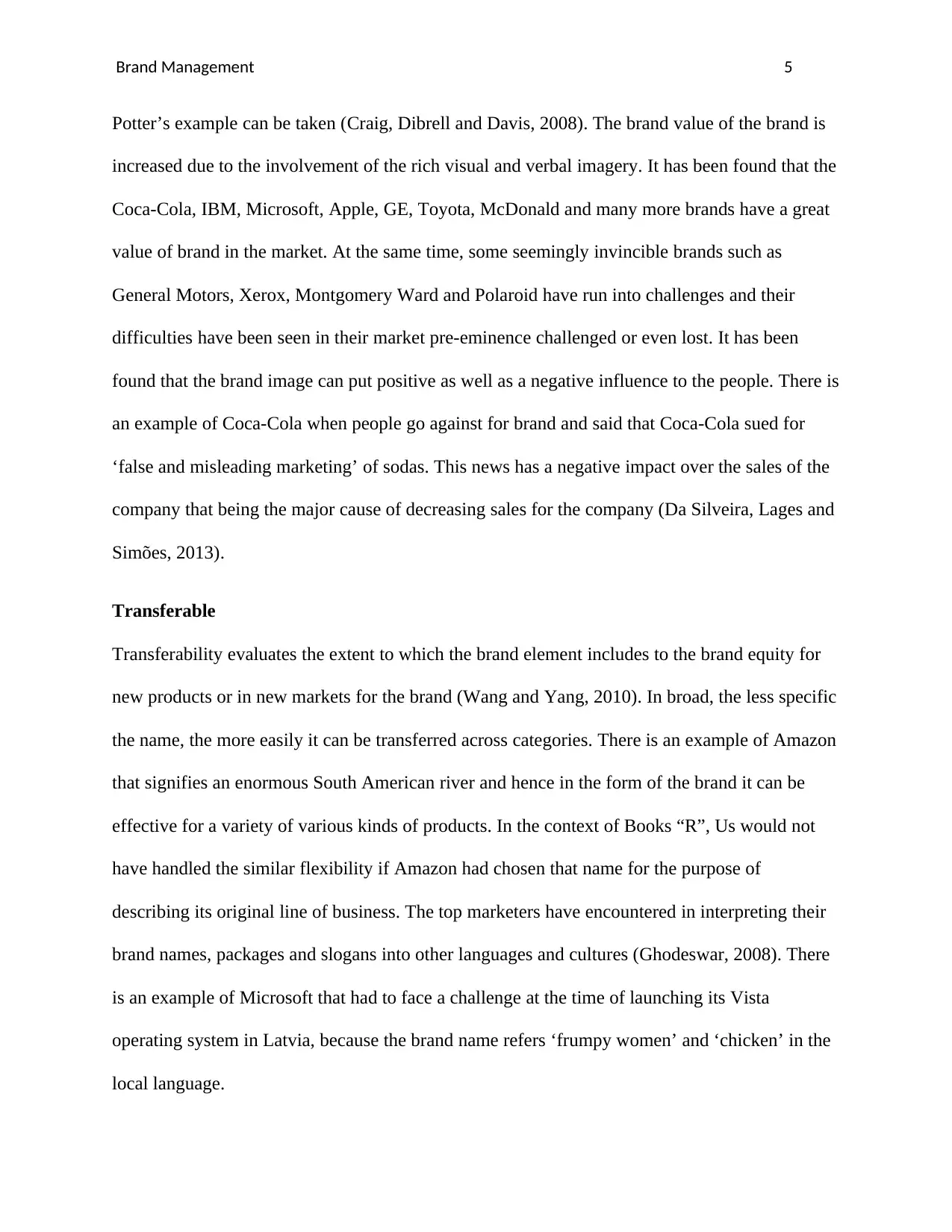
Brand Management 5
Potter’s example can be taken (Craig, Dibrell and Davis, 2008). The brand value of the brand is
increased due to the involvement of the rich visual and verbal imagery. It has been found that the
Coca-Cola, IBM, Microsoft, Apple, GE, Toyota, McDonald and many more brands have a great
value of brand in the market. At the same time, some seemingly invincible brands such as
General Motors, Xerox, Montgomery Ward and Polaroid have run into challenges and their
difficulties have been seen in their market pre-eminence challenged or even lost. It has been
found that the brand image can put positive as well as a negative influence to the people. There is
an example of Coca-Cola when people go against for brand and said that Coca-Cola sued for
‘false and misleading marketing’ of sodas. This news has a negative impact over the sales of the
company that being the major cause of decreasing sales for the company (Da Silveira, Lages and
Simões, 2013).
Transferable
Transferability evaluates the extent to which the brand element includes to the brand equity for
new products or in new markets for the brand (Wang and Yang, 2010). In broad, the less specific
the name, the more easily it can be transferred across categories. There is an example of Amazon
that signifies an enormous South American river and hence in the form of the brand it can be
effective for a variety of various kinds of products. In the context of Books “R”, Us would not
have handled the similar flexibility if Amazon had chosen that name for the purpose of
describing its original line of business. The top marketers have encountered in interpreting their
brand names, packages and slogans into other languages and cultures (Ghodeswar, 2008). There
is an example of Microsoft that had to face a challenge at the time of launching its Vista
operating system in Latvia, because the brand name refers ‘frumpy women’ and ‘chicken’ in the
local language.
Potter’s example can be taken (Craig, Dibrell and Davis, 2008). The brand value of the brand is
increased due to the involvement of the rich visual and verbal imagery. It has been found that the
Coca-Cola, IBM, Microsoft, Apple, GE, Toyota, McDonald and many more brands have a great
value of brand in the market. At the same time, some seemingly invincible brands such as
General Motors, Xerox, Montgomery Ward and Polaroid have run into challenges and their
difficulties have been seen in their market pre-eminence challenged or even lost. It has been
found that the brand image can put positive as well as a negative influence to the people. There is
an example of Coca-Cola when people go against for brand and said that Coca-Cola sued for
‘false and misleading marketing’ of sodas. This news has a negative impact over the sales of the
company that being the major cause of decreasing sales for the company (Da Silveira, Lages and
Simões, 2013).
Transferable
Transferability evaluates the extent to which the brand element includes to the brand equity for
new products or in new markets for the brand (Wang and Yang, 2010). In broad, the less specific
the name, the more easily it can be transferred across categories. There is an example of Amazon
that signifies an enormous South American river and hence in the form of the brand it can be
effective for a variety of various kinds of products. In the context of Books “R”, Us would not
have handled the similar flexibility if Amazon had chosen that name for the purpose of
describing its original line of business. The top marketers have encountered in interpreting their
brand names, packages and slogans into other languages and cultures (Ghodeswar, 2008). There
is an example of Microsoft that had to face a challenge at the time of launching its Vista
operating system in Latvia, because the brand name refers ‘frumpy women’ and ‘chicken’ in the
local language.
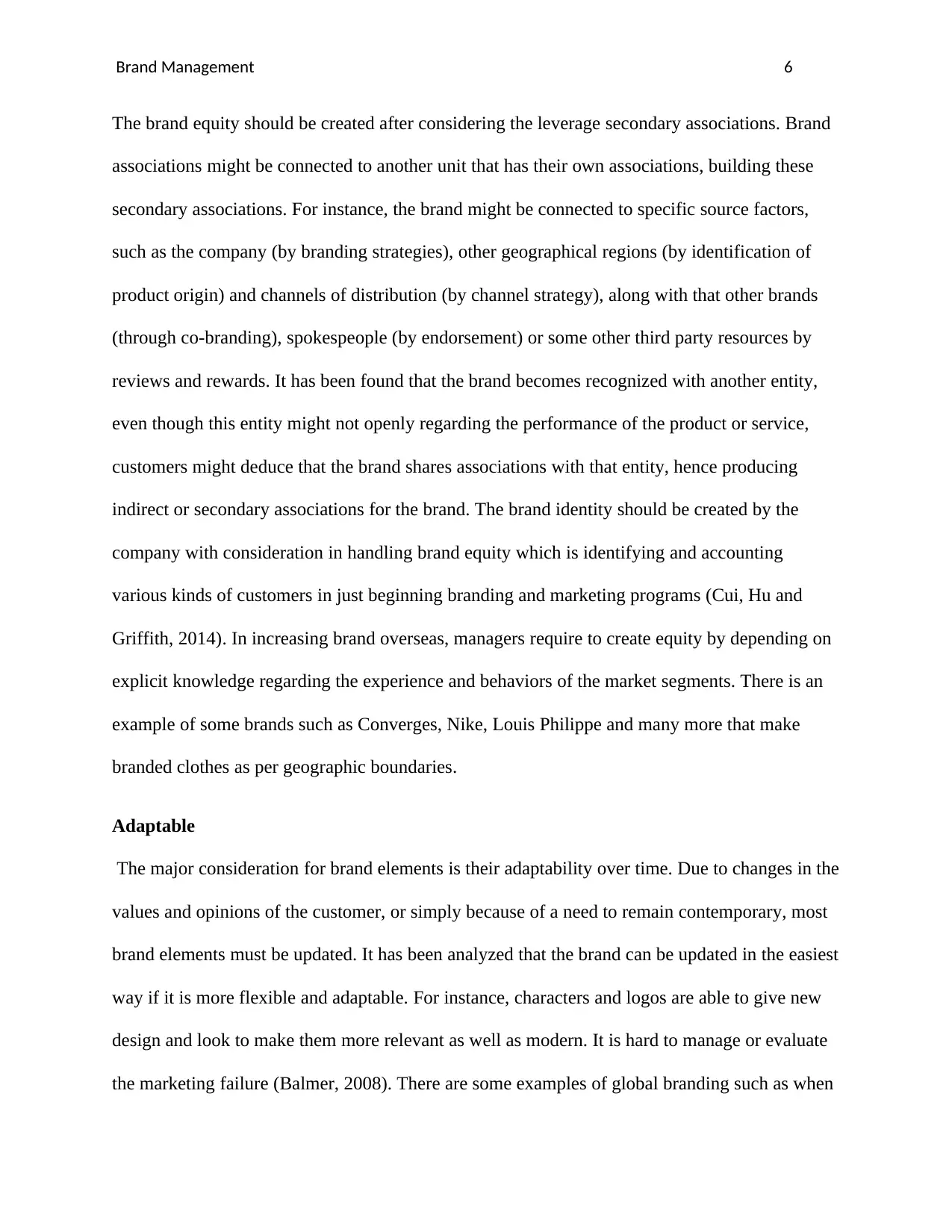
Brand Management 6
The brand equity should be created after considering the leverage secondary associations. Brand
associations might be connected to another unit that has their own associations, building these
secondary associations. For instance, the brand might be connected to specific source factors,
such as the company (by branding strategies), other geographical regions (by identification of
product origin) and channels of distribution (by channel strategy), along with that other brands
(through co-branding), spokespeople (by endorsement) or some other third party resources by
reviews and rewards. It has been found that the brand becomes recognized with another entity,
even though this entity might not openly regarding the performance of the product or service,
customers might deduce that the brand shares associations with that entity, hence producing
indirect or secondary associations for the brand. The brand identity should be created by the
company with consideration in handling brand equity which is identifying and accounting
various kinds of customers in just beginning branding and marketing programs (Cui, Hu and
Griffith, 2014). In increasing brand overseas, managers require to create equity by depending on
explicit knowledge regarding the experience and behaviors of the market segments. There is an
example of some brands such as Converges, Nike, Louis Philippe and many more that make
branded clothes as per geographic boundaries.
Adaptable
The major consideration for brand elements is their adaptability over time. Due to changes in the
values and opinions of the customer, or simply because of a need to remain contemporary, most
brand elements must be updated. It has been analyzed that the brand can be updated in the easiest
way if it is more flexible and adaptable. For instance, characters and logos are able to give new
design and look to make them more relevant as well as modern. It is hard to manage or evaluate
the marketing failure (Balmer, 2008). There are some examples of global branding such as when
The brand equity should be created after considering the leverage secondary associations. Brand
associations might be connected to another unit that has their own associations, building these
secondary associations. For instance, the brand might be connected to specific source factors,
such as the company (by branding strategies), other geographical regions (by identification of
product origin) and channels of distribution (by channel strategy), along with that other brands
(through co-branding), spokespeople (by endorsement) or some other third party resources by
reviews and rewards. It has been found that the brand becomes recognized with another entity,
even though this entity might not openly regarding the performance of the product or service,
customers might deduce that the brand shares associations with that entity, hence producing
indirect or secondary associations for the brand. The brand identity should be created by the
company with consideration in handling brand equity which is identifying and accounting
various kinds of customers in just beginning branding and marketing programs (Cui, Hu and
Griffith, 2014). In increasing brand overseas, managers require to create equity by depending on
explicit knowledge regarding the experience and behaviors of the market segments. There is an
example of some brands such as Converges, Nike, Louis Philippe and many more that make
branded clothes as per geographic boundaries.
Adaptable
The major consideration for brand elements is their adaptability over time. Due to changes in the
values and opinions of the customer, or simply because of a need to remain contemporary, most
brand elements must be updated. It has been analyzed that the brand can be updated in the easiest
way if it is more flexible and adaptable. For instance, characters and logos are able to give new
design and look to make them more relevant as well as modern. It is hard to manage or evaluate
the marketing failure (Balmer, 2008). There are some examples of global branding such as when
⊘ This is a preview!⊘
Do you want full access?
Subscribe today to unlock all pages.

Trusted by 1+ million students worldwide
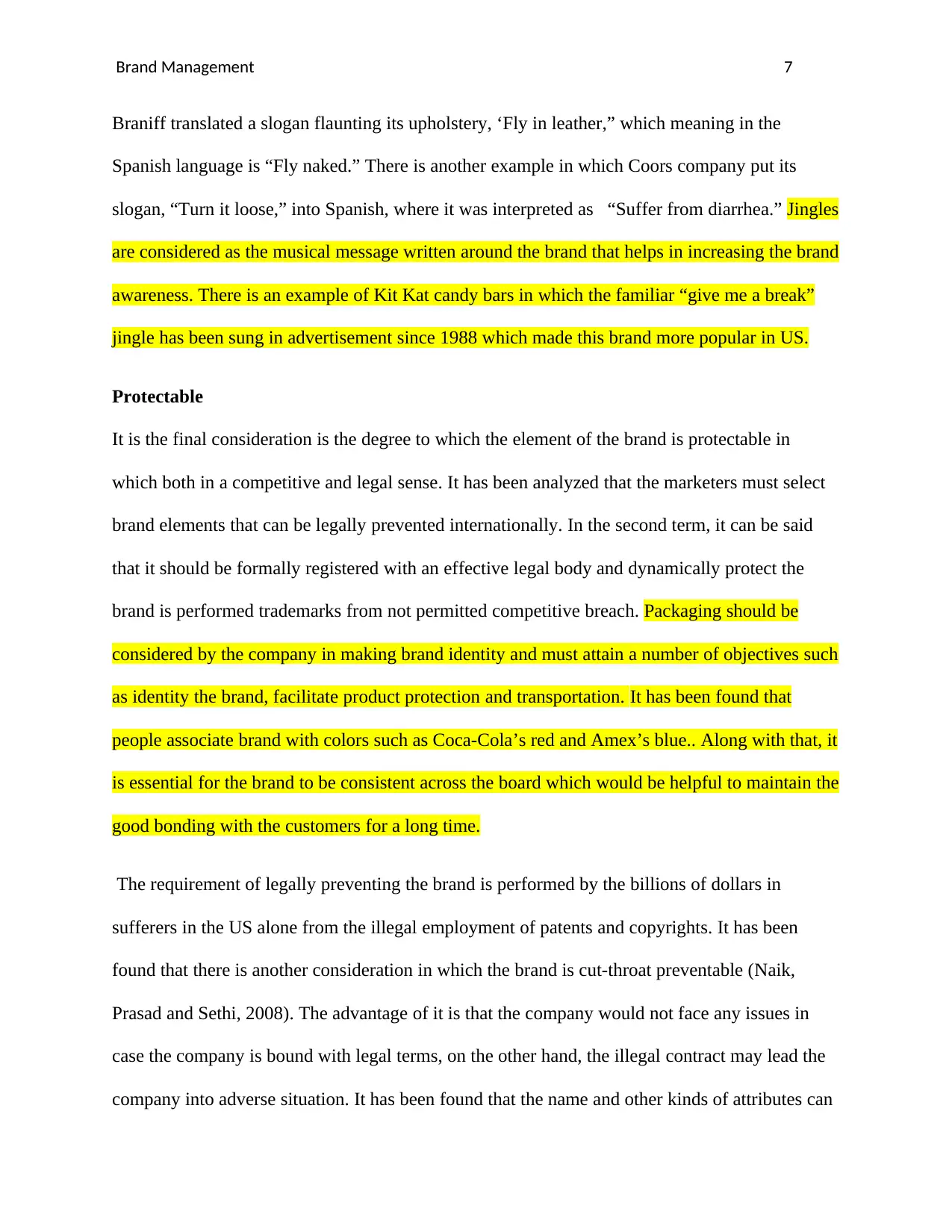
Brand Management 7
Braniff translated a slogan flaunting its upholstery, ‘Fly in leather,” which meaning in the
Spanish language is “Fly naked.” There is another example in which Coors company put its
slogan, “Turn it loose,” into Spanish, where it was interpreted as “Suffer from diarrhea.” Jingles
are considered as the musical message written around the brand that helps in increasing the brand
awareness. There is an example of Kit Kat candy bars in which the familiar “give me a break”
jingle has been sung in advertisement since 1988 which made this brand more popular in US.
Protectable
It is the final consideration is the degree to which the element of the brand is protectable in
which both in a competitive and legal sense. It has been analyzed that the marketers must select
brand elements that can be legally prevented internationally. In the second term, it can be said
that it should be formally registered with an effective legal body and dynamically protect the
brand is performed trademarks from not permitted competitive breach. Packaging should be
considered by the company in making brand identity and must attain a number of objectives such
as identity the brand, facilitate product protection and transportation. It has been found that
people associate brand with colors such as Coca-Cola’s red and Amex’s blue.. Along with that, it
is essential for the brand to be consistent across the board which would be helpful to maintain the
good bonding with the customers for a long time.
The requirement of legally preventing the brand is performed by the billions of dollars in
sufferers in the US alone from the illegal employment of patents and copyrights. It has been
found that there is another consideration in which the brand is cut-throat preventable (Naik,
Prasad and Sethi, 2008). The advantage of it is that the company would not face any issues in
case the company is bound with legal terms, on the other hand, the illegal contract may lead the
company into adverse situation. It has been found that the name and other kinds of attributes can
Braniff translated a slogan flaunting its upholstery, ‘Fly in leather,” which meaning in the
Spanish language is “Fly naked.” There is another example in which Coors company put its
slogan, “Turn it loose,” into Spanish, where it was interpreted as “Suffer from diarrhea.” Jingles
are considered as the musical message written around the brand that helps in increasing the brand
awareness. There is an example of Kit Kat candy bars in which the familiar “give me a break”
jingle has been sung in advertisement since 1988 which made this brand more popular in US.
Protectable
It is the final consideration is the degree to which the element of the brand is protectable in
which both in a competitive and legal sense. It has been analyzed that the marketers must select
brand elements that can be legally prevented internationally. In the second term, it can be said
that it should be formally registered with an effective legal body and dynamically protect the
brand is performed trademarks from not permitted competitive breach. Packaging should be
considered by the company in making brand identity and must attain a number of objectives such
as identity the brand, facilitate product protection and transportation. It has been found that
people associate brand with colors such as Coca-Cola’s red and Amex’s blue.. Along with that, it
is essential for the brand to be consistent across the board which would be helpful to maintain the
good bonding with the customers for a long time.
The requirement of legally preventing the brand is performed by the billions of dollars in
sufferers in the US alone from the illegal employment of patents and copyrights. It has been
found that there is another consideration in which the brand is cut-throat preventable (Naik,
Prasad and Sethi, 2008). The advantage of it is that the company would not face any issues in
case the company is bound with legal terms, on the other hand, the illegal contract may lead the
company into adverse situation. It has been found that the name and other kinds of attributes can
Paraphrase This Document
Need a fresh take? Get an instant paraphrase of this document with our AI Paraphraser
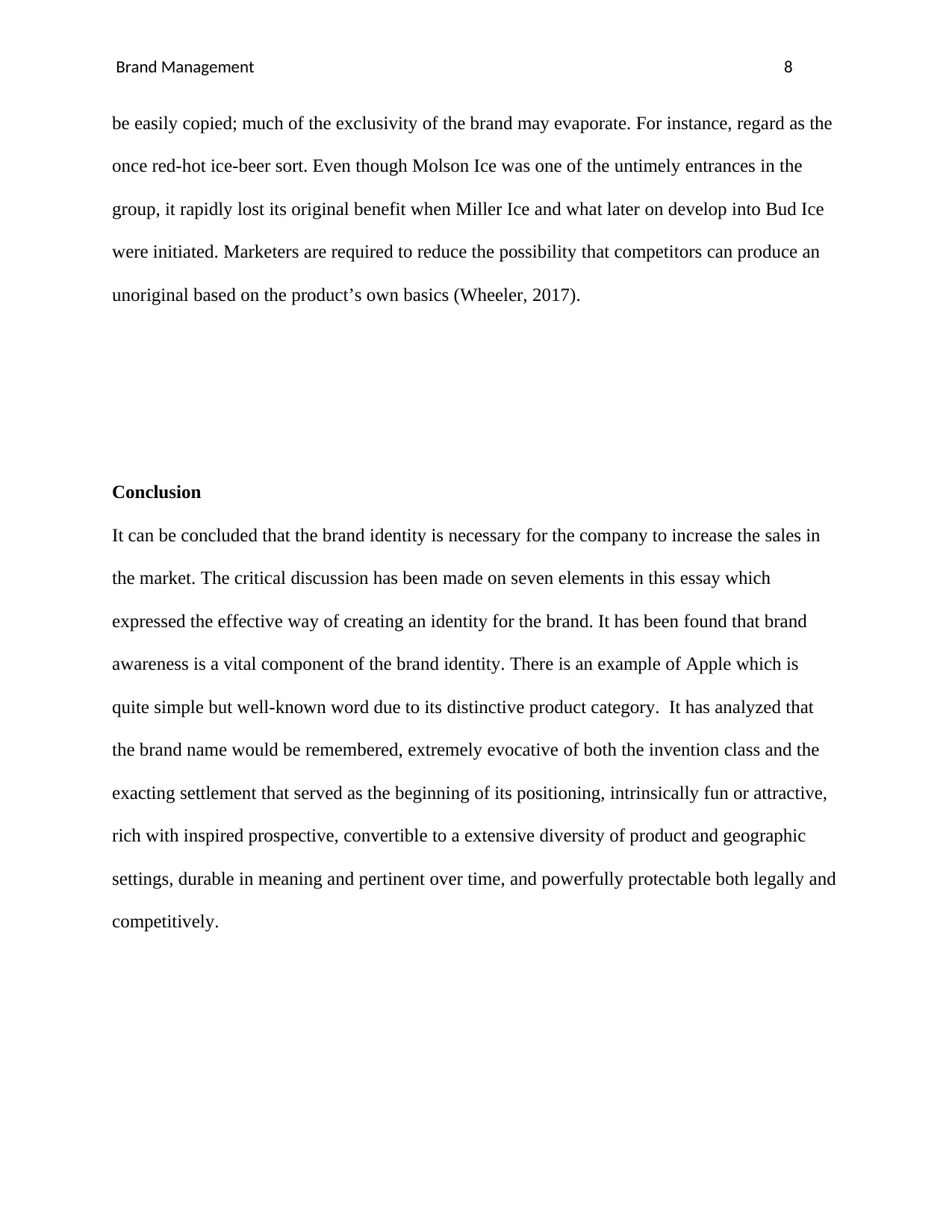
Brand Management 8
be easily copied; much of the exclusivity of the brand may evaporate. For instance, regard as the
once red-hot ice-beer sort. Even though Molson Ice was one of the untimely entrances in the
group, it rapidly lost its original benefit when Miller Ice and what later on develop into Bud Ice
were initiated. Marketers are required to reduce the possibility that competitors can produce an
unoriginal based on the product’s own basics (Wheeler, 2017).
Conclusion
It can be concluded that the brand identity is necessary for the company to increase the sales in
the market. The critical discussion has been made on seven elements in this essay which
expressed the effective way of creating an identity for the brand. It has been found that brand
awareness is a vital component of the brand identity. There is an example of Apple which is
quite simple but well-known word due to its distinctive product category. It has analyzed that
the brand name would be remembered, extremely evocative of both the invention class and the
exacting settlement that served as the beginning of its positioning, intrinsically fun or attractive,
rich with inspired prospective, convertible to a extensive diversity of product and geographic
settings, durable in meaning and pertinent over time, and powerfully protectable both legally and
competitively.
be easily copied; much of the exclusivity of the brand may evaporate. For instance, regard as the
once red-hot ice-beer sort. Even though Molson Ice was one of the untimely entrances in the
group, it rapidly lost its original benefit when Miller Ice and what later on develop into Bud Ice
were initiated. Marketers are required to reduce the possibility that competitors can produce an
unoriginal based on the product’s own basics (Wheeler, 2017).
Conclusion
It can be concluded that the brand identity is necessary for the company to increase the sales in
the market. The critical discussion has been made on seven elements in this essay which
expressed the effective way of creating an identity for the brand. It has been found that brand
awareness is a vital component of the brand identity. There is an example of Apple which is
quite simple but well-known word due to its distinctive product category. It has analyzed that
the brand name would be remembered, extremely evocative of both the invention class and the
exacting settlement that served as the beginning of its positioning, intrinsically fun or attractive,
rich with inspired prospective, convertible to a extensive diversity of product and geographic
settings, durable in meaning and pertinent over time, and powerfully protectable both legally and
competitively.

Brand Management 9
References
References
⊘ This is a preview!⊘
Do you want full access?
Subscribe today to unlock all pages.

Trusted by 1+ million students worldwide
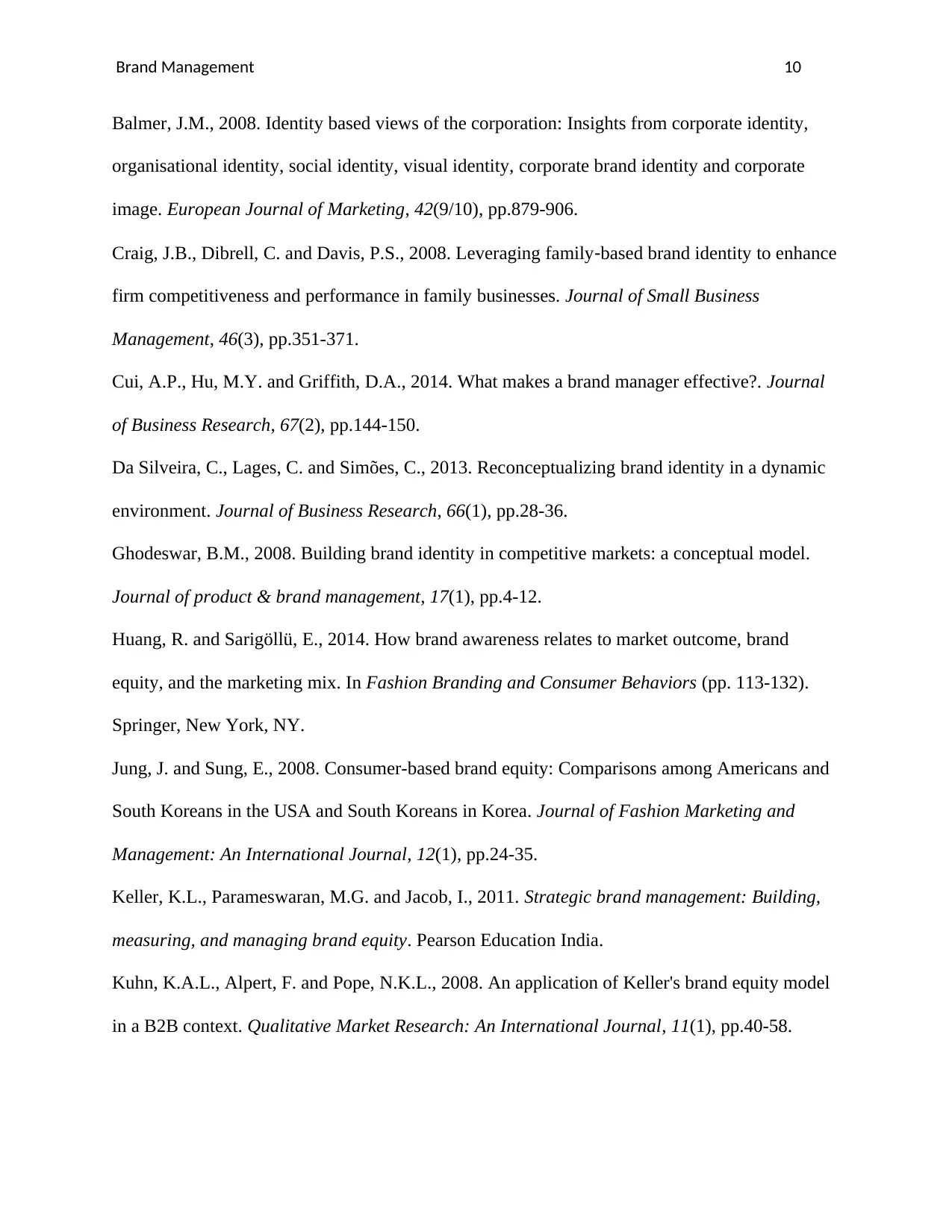
Brand Management 10
Balmer, J.M., 2008. Identity based views of the corporation: Insights from corporate identity,
organisational identity, social identity, visual identity, corporate brand identity and corporate
image. European Journal of Marketing, 42(9/10), pp.879-906.
Craig, J.B., Dibrell, C. and Davis, P.S., 2008. Leveraging family‐based brand identity to enhance
firm competitiveness and performance in family businesses. Journal of Small Business
Management, 46(3), pp.351-371.
Cui, A.P., Hu, M.Y. and Griffith, D.A., 2014. What makes a brand manager effective?. Journal
of Business Research, 67(2), pp.144-150.
Da Silveira, C., Lages, C. and Simões, C., 2013. Reconceptualizing brand identity in a dynamic
environment. Journal of Business Research, 66(1), pp.28-36.
Ghodeswar, B.M., 2008. Building brand identity in competitive markets: a conceptual model.
Journal of product & brand management, 17(1), pp.4-12.
Huang, R. and Sarigöllü, E., 2014. How brand awareness relates to market outcome, brand
equity, and the marketing mix. In Fashion Branding and Consumer Behaviors (pp. 113-132).
Springer, New York, NY.
Jung, J. and Sung, E., 2008. Consumer-based brand equity: Comparisons among Americans and
South Koreans in the USA and South Koreans in Korea. Journal of Fashion Marketing and
Management: An International Journal, 12(1), pp.24-35.
Keller, K.L., Parameswaran, M.G. and Jacob, I., 2011. Strategic brand management: Building,
measuring, and managing brand equity. Pearson Education India.
Kuhn, K.A.L., Alpert, F. and Pope, N.K.L., 2008. An application of Keller's brand equity model
in a B2B context. Qualitative Market Research: An International Journal, 11(1), pp.40-58.
Balmer, J.M., 2008. Identity based views of the corporation: Insights from corporate identity,
organisational identity, social identity, visual identity, corporate brand identity and corporate
image. European Journal of Marketing, 42(9/10), pp.879-906.
Craig, J.B., Dibrell, C. and Davis, P.S., 2008. Leveraging family‐based brand identity to enhance
firm competitiveness and performance in family businesses. Journal of Small Business
Management, 46(3), pp.351-371.
Cui, A.P., Hu, M.Y. and Griffith, D.A., 2014. What makes a brand manager effective?. Journal
of Business Research, 67(2), pp.144-150.
Da Silveira, C., Lages, C. and Simões, C., 2013. Reconceptualizing brand identity in a dynamic
environment. Journal of Business Research, 66(1), pp.28-36.
Ghodeswar, B.M., 2008. Building brand identity in competitive markets: a conceptual model.
Journal of product & brand management, 17(1), pp.4-12.
Huang, R. and Sarigöllü, E., 2014. How brand awareness relates to market outcome, brand
equity, and the marketing mix. In Fashion Branding and Consumer Behaviors (pp. 113-132).
Springer, New York, NY.
Jung, J. and Sung, E., 2008. Consumer-based brand equity: Comparisons among Americans and
South Koreans in the USA and South Koreans in Korea. Journal of Fashion Marketing and
Management: An International Journal, 12(1), pp.24-35.
Keller, K.L., Parameswaran, M.G. and Jacob, I., 2011. Strategic brand management: Building,
measuring, and managing brand equity. Pearson Education India.
Kuhn, K.A.L., Alpert, F. and Pope, N.K.L., 2008. An application of Keller's brand equity model
in a B2B context. Qualitative Market Research: An International Journal, 11(1), pp.40-58.
Paraphrase This Document
Need a fresh take? Get an instant paraphrase of this document with our AI Paraphraser
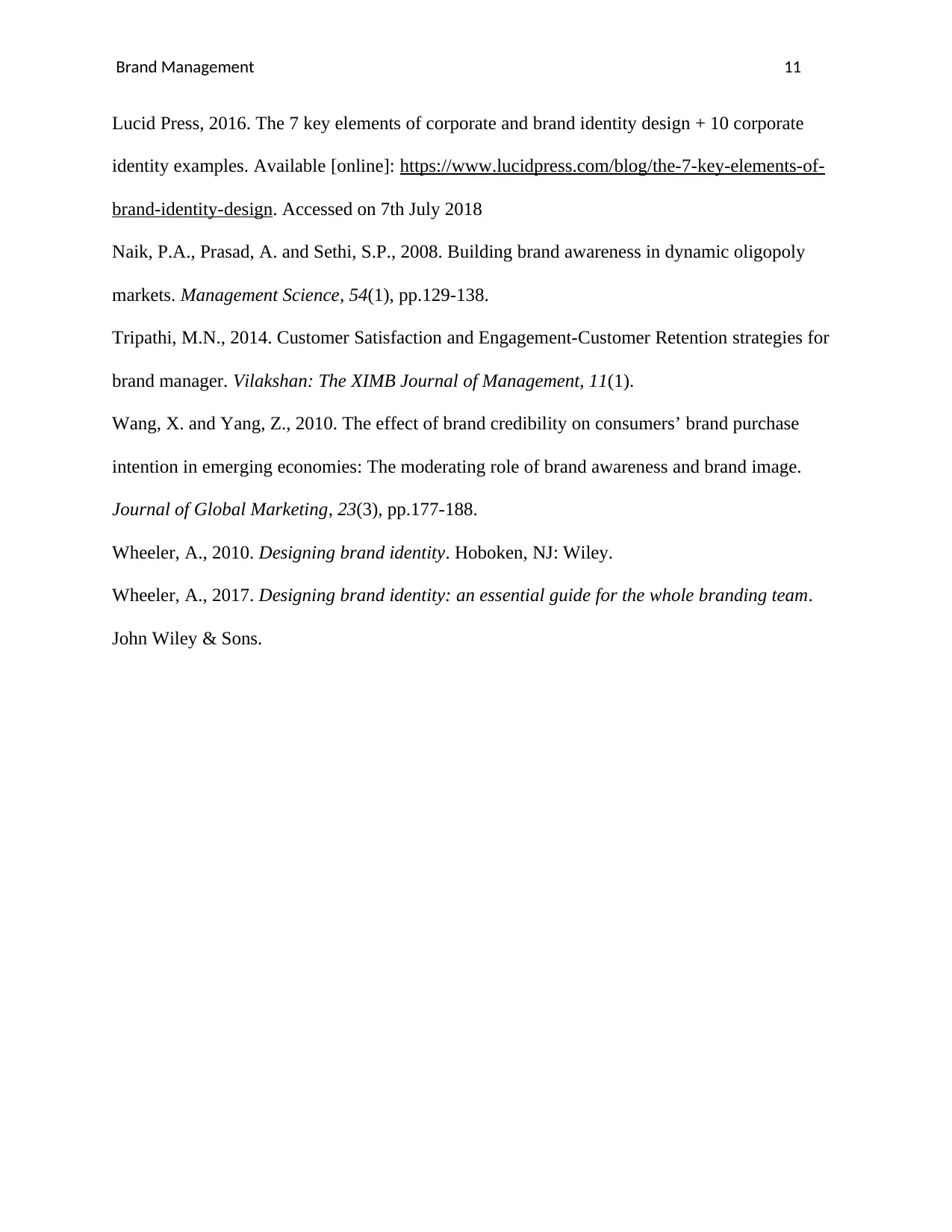
Brand Management 11
Lucid Press, 2016. The 7 key elements of corporate and brand identity design + 10 corporate
identity examples. Available [online]: https://www.lucidpress.com/blog/the-7-key-elements-of-
brand-identity-design. Accessed on 7th July 2018
Naik, P.A., Prasad, A. and Sethi, S.P., 2008. Building brand awareness in dynamic oligopoly
markets. Management Science, 54(1), pp.129-138.
Tripathi, M.N., 2014. Customer Satisfaction and Engagement-Customer Retention strategies for
brand manager. Vilakshan: The XIMB Journal of Management, 11(1).
Wang, X. and Yang, Z., 2010. The effect of brand credibility on consumers’ brand purchase
intention in emerging economies: The moderating role of brand awareness and brand image.
Journal of Global Marketing, 23(3), pp.177-188.
Wheeler, A., 2010. Designing brand identity. Hoboken, NJ: Wiley.
Wheeler, A., 2017. Designing brand identity: an essential guide for the whole branding team.
John Wiley & Sons.
Lucid Press, 2016. The 7 key elements of corporate and brand identity design + 10 corporate
identity examples. Available [online]: https://www.lucidpress.com/blog/the-7-key-elements-of-
brand-identity-design. Accessed on 7th July 2018
Naik, P.A., Prasad, A. and Sethi, S.P., 2008. Building brand awareness in dynamic oligopoly
markets. Management Science, 54(1), pp.129-138.
Tripathi, M.N., 2014. Customer Satisfaction and Engagement-Customer Retention strategies for
brand manager. Vilakshan: The XIMB Journal of Management, 11(1).
Wang, X. and Yang, Z., 2010. The effect of brand credibility on consumers’ brand purchase
intention in emerging economies: The moderating role of brand awareness and brand image.
Journal of Global Marketing, 23(3), pp.177-188.
Wheeler, A., 2010. Designing brand identity. Hoboken, NJ: Wiley.
Wheeler, A., 2017. Designing brand identity: an essential guide for the whole branding team.
John Wiley & Sons.
1 out of 11
Related Documents
Your All-in-One AI-Powered Toolkit for Academic Success.
+13062052269
info@desklib.com
Available 24*7 on WhatsApp / Email
![[object Object]](/_next/static/media/star-bottom.7253800d.svg)
Unlock your academic potential
Copyright © 2020–2025 A2Z Services. All Rights Reserved. Developed and managed by ZUCOL.





